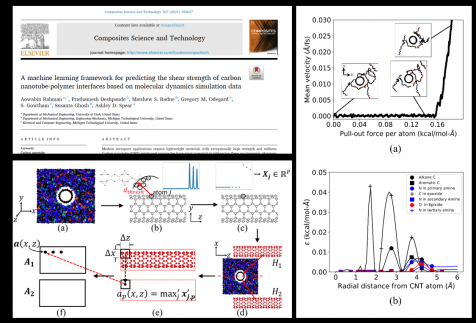Abstract
Modern aerospace applications require lightweight materials with exceptionally high strength and stiffness. Carbon nanotube (CNT)-reinforced composites have great potential in addressing these requirements. However, one critical factor limiting the potential of CNT-reinforced composites is the limited load transfer capability between CNTs through a polymer matrix, which arises due to low CNT-polymer interfacial shear strength at a molecular scale. While molecular dynamics (MD) simulations can be employed to investigate the CNT-polymer interface, such simulations are computationally expensive. It is thus intractable to explore a sufficiently large design space for interface modifications and optimization using MD simulations alone, motivating the use of surrogate models to efficiently map CNT-polymer interfacial configurations to interfacial strength. In this paper, we develop a surrogate machine learning model trained with MD models of functionalized CNT-epoxy and the corresponding interfacial shear strength. The proposed ML model consists of (i) a feature representation of CNT-epoxy based on radial distribution functions; (ii) a convolutional neural network model to map feature representations to a metric of interfacial shear strength; and (iii) a data augmentation method to maximize the use of limited training data. The proposed ML model can predict the CNT pullout force quite well despite a large variation associated with the pullout force.
Authors: Aowabin Rahman, Prathamesh Deshpande, Matthew Radue, Gregory Odegard, S. Gowtham, Susanta Ghosh, Ashley Spear
This research was supported by the NASA Space Technology Research Institute (STRI) for Ultra-Strong Composites by Computational Design (US-COMP) [grant number NNX17AJ32G]. The support and resources of the Center for High Performance Computing at the University of Utah are gratefully acknowledged.
Access article: 2021_Rahman_CST

